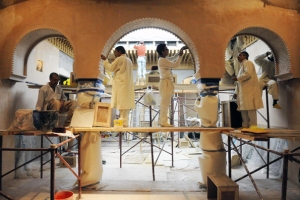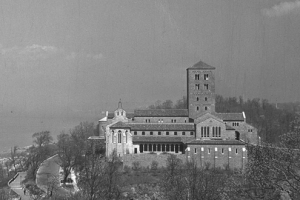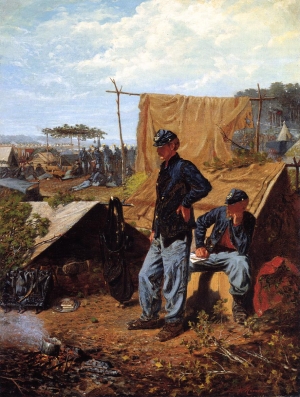|
Displaying items by tag: Metropolitan Museum of Art

Following the lead of the Metropolitan Museum of Art and PBS, Google will launch a series of monthly digital “Art Talks.” The project aims to bring gallery and museum collections to life through virtual hangouts with curators, museums directors, historians, and educators from the world’s most distinguished cultural institutions. The talks will explore various arts-related topics including the curating process, popular themes throughout art history, art education, and the significance of specific masterpieces and artists.
The first Art Talks hangout will take place at 8PM on March 6, 2013 at the Museum of Modern Art in New York City. Deborah Howes, the museum’s Director of Digital Learning, will join a panel of artists and students to discuss the process of teaching art online.
Upcoming Art Talks include Caroline Campbell and Arnika Schmidt from London’s National Gallery discussing depictions of the female nude throughout art history (March 20, 2013) and a panel discussion of Pieter Bruegel the Elder’s (1525-1569) Tower of Babel featuring Peter Parshall, curator at the National Gallery of Art in Washington, D.C. (April 2013). Additional talks are planned for the Metropolitan Museum of Art in New York, the Museum of Contemporary Art in Los Angeles, and the Museo Nacional de Arte in Mexico.
The talks will be posted on the Google Art Project‘s YouTube channel after they air.

An exhibition titled At War with the Obvious: Photographs by William Eggleston is now on view at the Metropolitan Museum of Art in New York. William Eggleston (b. 1939) became pioneering force in modern photography during the 1960s and helped legitimize color photography as a respected art form. He also popularized the dye-transfer color process, a practice that until then was primarily used by commercial photographers. Eggleston, who remains a prominent figure in the modern art world, draws inspiration from a number of sources including the photography of Robert Frank (b. 1924) and Henri Cartier-Bresson (1908-2004) as well as the musical compositions of Johann Bach.
A native of the Mississippi delta region, Eggleston’s photographs often depict the inhabitants as well as the physical landscape of the area. Drawn to seemingly ordinary subject matters, Eggleston is able to evoke a sense of complexity and raw beauty from the mundane. Often featuring roadside snapshots, backyard barbeques, parking lots, and diners, Eggleston’s photographs act as a lush interpretation of the American vernacular.
At War with the Obvious commemorates the Met’s acquisition of 36 dye-transfer prints by Eggleston, which took place in the fall of 2012. The addition fleshed out the museum’s Eggleston collection and included his first portfolio of color photographs from 1974, 15 prints from his seminal book, William Eggleston’s Guide (1976), and seven other important works from a career that has spanned over 50 years.
At War with the Obvious features a number of Eggleston’s most recognizable images including Untitled (Peaches!) (1970), Untitled (Greenwood, Mississippi) (1980), and Untitled (Memphis) (1970). The exhibition will be on view through July 28, 2013.

French president Francois Hollande has given special allowance to Édouard Manet’s (1832-1883) Olympia (1863), permitting the masterpiece to travel from Paris to Venice for an exhibition. It will be the first time the influential painting has left the French city since it was given to the nation in 1890. Olympia, which features a nude woman and her fully clothed maid, shocked audiences with its subject’s provocative gaze and the suggestion that she was a prostitute.
Olympia, which is part of the Musée d’Orsay’s collection, will travel to Italy to anchor an exhibition at the Doge’s Palace in Venice. The painting will appear alongside Titian’s (1485-1576) The Venus of Urbino (1538), which is on loan from Florence’s Uffizi Gallery, as part of the exhibition Manet: Return to Venice. The exhibition features 70 works including 42 paintings by Manet on loan from the Musée d’Orsay, which will received a considerable amount in fees for the unprecedented loan. A number of paintings will also be on loan from the Metropolitan Museum of Art in New York.
Manet: Return to Venice will explore how Italian artists such as Vittore Carpaccio (1460-1520), Antonello da Messina (1430-1479), and Lorenzo Lotto (1480-1556) influenced the French painter. The exhibition will be on view from April 25 to August 4, 2013.

New York’s Metropolitan Museum of Art, the largest art museum in the United States, can be difficult to navigate in a short period time. With over two million works in its collection, visitors to the Met usually spend a few minutes with an object before moving on to one of the many masterpieces that awaits them. In an effort to highlight some of the museum’s not-to-be-missed objects, Met officials have launched the web series, 82nd & Fifth, aptly named after the museum’s Manhattan location.
The series presents 100 pieces from the Met’s vast collection in separate episodes. During each episode, a museum curator explains the work’s significance, not just to the art world and the museum, but also to them on a personal level.
The Met has already posted six 2-½ to 3-minute videos, which include interactive features, on the 82nd & Fifth web page. Highlighted works include a room with furnishings designed by Frank Lloyd Wright (1867-1959) between 1912 and 1915, a Renaissance relief sculpture by Antonio Rossellino (1427-circa 1478/1481), Giovanni Battista Tiepolo’s (1696-1770) massive painting The Triumph of Marius (1729), and an etching by Rembrandt (1606-1669) titled Christ Crucified Between Two Thieves: The Three Crosses (1653).
The Met will post two new videos on Wednesday morning of each week through December 25, 2013.

The Metropolitan Museum of Art in New York announced that on January 18, 2013, the number of visitors to the New Galleries for the Art of the Arab Lands, Turkey, Iran, Central Asia, and Later South Asia hit the one million mark. The renovated galleries, which reopened to the public on November 1, 2011, draw approximately 2,550 patrons each day.
The Met’s Islamic Art collection, which is comprised of over 1,200 works and spans 1,300 years, is considered one of the most comprehensive collections of its kind. The holdings are presented in 15 different galleries, the result of an eight-year project that included renovations, expansions, and reinstallations.
Thomas P. Campbell, Director and CEO of The Metropolitan Museum of Art, said, “Since these galleries reopened in their new configuration just over a year ago, we have been truly gratified by the exceptional interest that our visitors – both local and international – have taken in this newly conceived presentation of Islamic art.”
To commemorate the Met’s milestone, the one-millionth visitor to the Islamic art galleries received a catalogue of the collection.

Built in the 1930s in northern Manhattan’s Fort Tryon Park on land donated by John D. Rockefeller Jr., The Cloisters, a branch of the Metropolitan Museum of Art, is a sight to be seen. Assembled from architectural elements dating from the 12th through 15th century, The Cloisters, which includes landscaped gardens, features a collection of nearly 3,000 works of art from medieval Europe.
Besides an impressive collection and scenic gardens, The Cloisters boasts a picturesque view of the Palisades, a line of steep cliffs that run along the lower Hudson River. Rockefeller’s grandson, Larry, is teaming up with the Met, to preserve the vista, which risks being obscured by LG Electronics’ new corporate headquarters in Englewood Cliffs, NJ.
The plans for the new LG location have the building stretching upward 143 feet, standing several stories above the tree line almost directly across the Hudson River from the Cloisters. Rockefeller, who has met with LG officials to discuss altering the building’s plans, is not alone in his concerns. A number of environmental groups have also filed lawsuits asking the company to reduce the new headquarters’ height. The Met has also written letters pleading with LG as well as a judge handling one of the environmental cases.
Designed by architecture giant HOK, LG will begin construction on 27 acres this year. The project is expected to conclude by 2016.

A formal ground-breaking ceremony for the Metropolitan Museum of Art’s new David H. Koch Plaza was held on January 14, 2013 in New York. The $65 million project, which was announced in February 2012, has been underway since October but was postponed due to complications associated with Hurricane Sandy. The plaza is expected to reach completion in the fall of 2014.
Funded by Met trustee and philanthropist, David H. Koch, the project includes the installation of new fountains and the redesign of a four-block-long outdoor plaza that runs in front of the Met’s Fifth Avenue façade from 80th to 84th Streets. The sidewalks alongside the museum’s entrance, which see six million pedestrians a year, will also be repaired.
While the Met has made a number of indoor improvements over the years, the outdoor overhaul is much needed. Built in the 1970s along with the existing plaza, the museum’s original fountains, which are now deteriorated, will be replaced by contemporary granite fountains. The new structures will be positioned closer to the museum’s front steps, improving access to the street-level entrances. The redesign also includes tree-shaded allées, improved seating areas, and energy-efficient lighting. The Met’s iconic front steps will be left untouched.
Philadelphia-based landscape architecture and urban design firm, Olin, will be the lead design consultants for the project.

The Smithsonian in Washington, D.C. is currently hosting a number of events commemorating the 150th anniversary of the arrival of the Emancipation Proclamation (1963) during the Civil War (1861-1865). The exhibition, The Civil War and American Art, focuses on how the devastation, emotions, and revolution associated with the war affected what appeared on the canvas for many artists working at the time.
Now on view at the Smithsonian’s American Art Museum, The Civil War and American Art relies on Winslow Homer (1836-1910), Eastman Johnson (1824-1906), Frederic Church (1826-1900), and Sanford Gifford (1823-1880) to ground the show. Through 75 works including paintings and vintage photographs, the exhibition creates a linear model, which mirrors the progression of the Civil War as a sense of unease on the eve of war transitioned to hope that the conflict would be resolved speedily to the harsh realization that there were too many wrongs to be righted quickly. Genre and landscape painters best captured the transformative effect of the Civil War as amber waves of grain were reduced to trampled crops, burned-down trees, and blood-soaked fields littered with bodies. There was also much to grapple with as the war ended and the country was left to restore itself and its identity.
The photography component of the exhibition includes snapshots taken on the battlefield by Alexander Gardner (1821-1882), Timothy H. O’Sullivan (1840-1882), and George Barnard (1819-1902). These photographs, which document the Civil War’s carnage and destruction, shed light on the very real devastation that was suffered by many.
The Civil War and American Art will be on view at the Smithsonian through April 28, 2013 and will travel to the Metropolitan Museum of Art (May 21-September 2, 2013) in New York after its run in Washington.

On view through January 27, 2013 at the Metropolitan Museum of Art in New York, Extravagant Inventions: The Princely Furniture of the Roentgen’s is the first comprehensive exhibition to focus on the Roentgen family’s cabinetmaking firm, which operated from 1742 into the early 1800s. Extravagant Inventions presents around sixty pieces of furniture, many of which have never been seen outside of Europe.
Abraham Roentgen (1711-1793) and his son David (1743-1807) were pioneering figures in 18th century Continental furnituremaking. Based in Germany, the Roentgen firm’s style is characterized by opulence, inventiveness (they often incorporated hidden compartments and secret drawers into their works), and ornate, finely carved shapes. The Roentgens served clients around Europe including France’s Louis XVI and Marie Antoinette and Russia’s Catherine the Great.
Extravagant Inventions brings together works from various international collections as well as six works from the Met’s own holdings. Highlights include a writing desk (circa 1758-1762) designed by Abraham Roentgen and considered one of the greatest creations from his workshop, a mechanical secretary cabinet (1779) made for King Friedrich Wilhelm II of Prussia, and a pair of marquetry portraits (1775-1780) depicting a man and a woman, which exemplifies the marquetry technique the Roentgens were renowned for.

In December 2010, Pierre Konowaloff, the heir to Russian art collector Ivan Morozov, filed a lawsuit claiming that he was the rightful owner of Paul Cézanne’s (1839-1906) painting Madame Cézanne in the Conservatory (1891), not the Metropolitan Museum of Art. Konowaloff explained that Morozov’s art collection was seized by the Bolshevik regime in 1918 and that when Stephen Clark, the collector and museum trustee who bequeathed the work to the Met in 1960, first bought the painting from Knoedler & Company in 1933, he did not carry out due diligence. Accusing the Met of wrongful acquisition, possession, display and retention, Konowaloff demanded that the work be returned to him and requested restitution for monetary damages.
On December 18, a judge in the 2nd District Court of Appeals in Manhattan ruled that the Met could keep the Cézanne masterpiece, as the museum remains the work’s rightful owner. The Met has stood behind their right to the painting since the beginning of the entanglement with Konowaloff. The lawsuit was initially dismissed in 2011 by judge Shira Scheindlin who said that a U.S. court has no basis for questioning a decision made by a foreign government on distant soil. After the rejection of Konowaloff’s appeal, Met officials can finally leave the dispute behind them.
Konowaloff filed a similar suit against Yale University in 2009 over Vincent van Gogh’s (1853-1890) The Night Café (1888). Konowaloff claimed that the van Gogh painting was also stolen during the Russian Revolution and bought by Clark regardless of its questionable history.
|
|
|
|
|